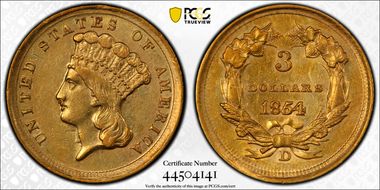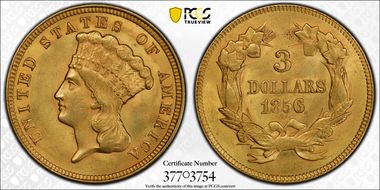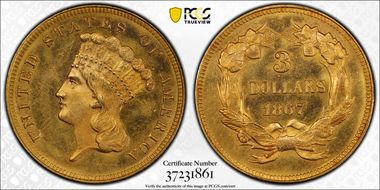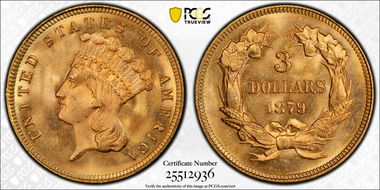JD's $3 Basic Set 的钱币相册
CAC. This date is the first year of issue and it is a single year design variant, with small letters in DOLLARS on the reverse. Beginning in 1855, and continuing through 1889, the letters were much larger. The surfaces are clean and have a thick satiny texture. Only when using a strong glass can you detect a small scuff and a line or two-nothing that diminishes the grade. A strong glowing luster enhances the totally original gold colors. Purchased from Heritage.
This example shows good striking details overall, although the denticles around the upper half of each side are typically either weak or missing. The green-gold coloration is enhanced by orange-gold highlights, particularly on the reverse. Die clash marks are observed in the central reverse fields, and closely adjacent to Liberty's throat and upper lip. A few minor abrasions are found under close examination, but this is a very nice representative from this mint. Purchased from Crescent City Numismatics; ex: H 10/2006: 2635.
CAC; Winter Variety 2. The 1854-O is the only Three Dollar gold piece struck at the New Orleans Mint. This piece is a beautiful example of crusty old gold. Pale golden interiors deepen to orange toward the margins. Though light wear is noted on the high points, the generous semi-reflective luster remaining in the fields reinforces the near-Mint status of the piece. Purchased from Crescent City Numismatics; ex: LRCA 5/22: 198; Doug Winter; LRCA 12/15: 425; Heritage 10/12: 5776.
CAC. The 1855 is among the more available dates of this design in the low to medium Uncirculated grades but it is scarce in properly graded MS64 and very rare in Gem. PCGS has graded four in MS65 and the Pogue coin, optimistically graded MS66, is likely the finest known. This exceptional borderline Gem has impeccable surfaces which approximate what you would see (or not see!) on a Gem. The color is a pleasing deep orange-gold with contrasting reddish tints at much of the obverse border. A few wispy lines in the left obverse field narrowly remove this coin from a Gem grade and a $25,000 price tag. Purchased from Doug Winter; ex: SB 10/15: 63; HA 8/13: 5818.
CAC. The 1856 is reasonably available in MS62 and below. The present example has a good strike with some weakness in the lower hair curls. The luster is subtle and satiny. The color is yellow gold with attractive orange gold toning feathering toward the edges.
CAC and Second Finest Known. The 1857 $3 mintage of 20,891 pieces was more than 5,000 coins fewer than the Philadelphia Mint output of the previous year, and not surprisingly, the 1857 is slightly rarer in Mint State than its 1856 counterpart. This example has a satiny deep yellow-gold color with luster that pools in the fields and springs forth from the protected design elements. The coin is smartly impressed from lightly clashed dies. The devices are full throughout the obverse while the reverse displays a trace of weakness at the right side of the bow. Light clash marks can be seen with the proper lighting, but precious little else will be revealed without a loupe. Vertical die striae engage both sides, signifying an early strike. Purchased from Legend Numismatics; ex: SB 2/16: 3096 (The D. Brent Pogue Collection, Part III); ex: Great Lakes Collection; Larry Hanks.
SSCA#2. Just 14,200 pieces were struck, nearly all of which were released into circulation and used extensively in West Coast trade. Prior to the recoveries from the S.S. Central America, only two Mint State 1857-S threes had been graded mint state. This piece is one of six $3 1857-S mint state coins recovered including an incredible MS67. This yellow-gold example retains most of its original semireflective surface on the obverse, while the reverse is lightly frosted across its smooth fields. Both sides show light, hair-thin abrasions and a few tiny marks. A sharp strike weakens only at the highest points of Liberty's curls, and bright mint luster shines throughout the obverse and reverse. Heritage 7/19: 3162.
CAC. Only 2,133 were struck and the 1858 is among the rarest Three Dollars from Philadelphia. This date was not saved (as were the low mintage issue from the 1880's) and it is a rarity in Uncirculated with around a dozen or so known. In April, 2018, Doug Winter stated “I'm going to go out on a limb here and state that this is the single nicest AU58 1858 Three Dollars known to exist”. This is a still-lustrous near-Mint State example with natural wheat-gold color and orange accents with just a touch of wear. Flecks of olive-brown toning add natural appeal to the CAC-endorsed surfaces. Sharp definition remains on both sides. Purchased from Doug Winter; ex: Heritage 3/18: 3134.
CAC. 15,558 pieces of the 1859 three dollar gold were struck. Both sides show exquisite deep natural golden-orange and rose hues. The strike is extremely sharp with none of the usual central weakness noted, and the surfaces show a few scattered ticks which are nicely hidden by the aforementioned rich color. This coin has terrific eye appeal for this issue. Purchased from Doug Winter.
CAC. The 1860 is an overlooked issue in the Three Dollar series with a low original mintage of just 7,036 circulation strikes. This date saw circulation prior to the onset of the Civil War and as a result, it is rare in Uncirculated; particularly so approaching the Gem level. There are around five or six known approaching or at the Gem level; this includes the PCGS MS67+ Pogue example (at $91,063 in early 2016), the PCGS MS67 Simpson coin and the PCGS MS67 Akers coin which brought a record-setting $114,563 at auction in 2014. This example is as close to being a Gem as possible with totally original orange-gold and greenish colors seen over unmolested frosty surfaces. Purchased from Doug Winter.
The 1860-S is the rarest of the four collectible Three Dollar gold pieces from this mint in terms of the total number known, and it narrowly trails the 1855-S as the rarest in high grades. There are an estimated four to five known in Uncirculated. This coin is totally free of wear with no luster breaks in the fields or rub on the high spots. It shows excellent luster and overall detail for the issue with natural light rose-gold color. Purchased from Doug Winter.
CAC. Fewer than six thousand were struck, and most known are in AU58 or lower grades. Miss Liberty and the details are exceptionally well struck. Superior surfaces have no visible distractions; even if you use a strong glass all you will find are a few microscopic ticks scattered around. There actually is a light layer of toning all over, as both sides have a semi dusky original gold color. Legend Auctions 7/20: 17.
CAC. The 1862 three dollar had a mintage of 5,750 pieces. That number is not unusually low for the series, but when one considers the hoarding and exportation of gold and silver coins during the Civil War it is not surprising that so few pieces exist today. The small mintage of 1862 threes was made in multiple press runs, but all were delivered on February 6, 1862. Two obverse and reverse dies were used. This coin was struck from heavily relapped dies, presumably after the dies clashed, and each side shows heavy vertical die striations. The obverse shows heavy polishing in the front of Liberty's neck, so heavy in fact that the front of the neck was partially effaced. The heavy die striations impart a bright, semiprooflike appearance to the fields, especially the reverse fields. The striking details are uncommonly strong when compared to many dates in this series with nearly complete definition in all areas and the color is orange-gold with rose highlights. Purchased from Legend Numismatics.
CAC. 1863 is a scarce Civil War date in the $3 Series. The current example has the characteristic clash marks for the date with weakness in Miss Liberty’s hair. The luster is a subdued and frosty; the color is green-gold with orange-gold highlights. Purchased from DLRC.
CAC. Only 2,630 business-strike three dollar gold pieces were struck in 1864, all delivered in two batches (440 pieces on February 25 and 2,190 examples on December 6). Accordingly, the 1864 is one of the most elusive dates of the series, especially in high grade, but its elusive nature is not often recognized, outside of series specialists. The present coin is an impressive Select example, with sharply detailed design elements in most areas, and just a trace of softness on the ribbon knot. The pleasing yellow-gold surfaces are lightly marked and show the light diagonal striations typical of this issue on the obverse. Both sides radiate vibrant mint luster, with a few hints of prooflike reflectivity in the fields. Purchased from Heritage.
CAC. With only 1,140 struck, the 1865 is by far the rarest Civil War date of this series, and it is the second rarest Philadelphia issue made for circulation. Miss Liberty and the details are fully struck and have generous frost. There are light traces of semi-Prooflike reflective texture mixed in with the glowing luster that beams from all over. There is some coppery color that frames all the devices. The rest of the coin is a faded orange-gold color. Legend Auctions 12/20: 27; ex: Heritage 8/17: 4110.
Just 4,000 Three Dollar gold pieces were made for circulation in 1866. This medium russet toned example has a semi-prooflike obverse and a more frosty reverse which shows diagonal basining lines, as made. Purchased from Doug Winter.
CAC. Only 2,600 business strike 1867 Three Dollar gold pieces were made, and this issue saw enough circulation (unlike the low mintages issues from the 1880’s) that high-grade pieces are scarce. There are around 30 known in Uncirculated but nearly all of these are low-end. The 1867 is extremely rare in Gem and there are just four examples known which are finer than this example: PCGS MS65 and MS66, the Bass coin (PCGS MS67+ CAC), and the amazing Akers coin which is now graded PCGS MS68. This piece is extremely frosty with a “look” which is uncommon for this issue. The surfaces are incredibly clean with just a few small ticks seen in the upper left obverse field while the strike is razor sharp. What appear to be hairlines on the reverse are mint-made diagonal die polishing lines which are seen on most 1867 Threes. Purchased from Doug Winter.
CAC. Only 4,850 were minted. The luster is bold and blazes from all over. Both sides enjoy a beautiful and totally original deeper gold color mix with highlights of reddish gold around the details. Miss Liberty and the details are sharply struck and have delicate frost. The eye appeal is excellent! Purchased from Crescent City Numismatics.
CAC. 1870 had an original mintage of only 3,500 coins. A fully Prooflike example from one of the most important cabinets of rare coins ever formed, Harry W. Bass, Jr. This coin was clearly struck early on and retains the full reflective texture to the fields. A wonderful two-tone coloration, with rich orange-gold and accents of icy-blue that add to the eye appeal. Rotate the flashy surfaces in a light and the frosted, well struck devices stand out with nearly a cameo effect. Purchased from Legend Numismatics; ex: Legend Auctions 1/19: 410; Bowers & Merena's Bass, Part II sale, October 1999, lot 687; earlier Superior, February 1973, lot 304.
The 1871 is a well-known date in the Three Dollar series due to its low mintage of just 1,300 business strikes. It is less scarce than this small figure would suggest, and it is likely that a small hoard of Uncirculated 1871 Threes existed at one time. This example is more frosty than reflective, and it shows the hallmark of a business strike with some weakness on the 18 in the date. Both sides have medium yellow-gold color and a few ticks can be seen in the upper left obverse field. Purchased from Doug Winter.
CAC. Only 2,000 business-strike three dollar gold pieces were struck in 1872. This near-GEM is almost certainly one of the three or four finest examples remaining from this date. This representative, with typically reflective fields and a solid strike, offers great visual appeal for the date. Only a few scattered wispy abrasions in the fields preclude an even finer designation. The gold color ranges from medium gold to rich honey-orange. Heritage 4/19: 3843; ex: HA 8/17: 4112; ex: HA 2/11: 4420.
CAC. The 1873 is believed to be the rarest business strike in the $3 series. This example has outstanding eye appeal for the date and for the grade. It is fully reflective on both sides but it is an obvious business strike with plenty of frost and weakness on the bow which would not be found on a Proof. The color is a pleasing medium yellow-gold and the surfaces are very choice with just a few minor ticks in the left obverse field which are consistent with the assigned grade.
CAC. The 1874 registers the highest mintage in the three-dollar series up to that point in time, and the second highest for the type as a whole (after the 1878). Circulation strikes were produced to the extent of 41,800 piece, as it was anticipated at the time that gold coins and Legal Tender notes would achieve parity in the market (in actuality this did not happen until December 17, 1878), and pieces were struck to fill the expected demand. Although Mint State survivors are plentiful by the standards of the type, no three-dollar gold issue can rightly be called common when viewed in the wider context of U.S. numismatics. This is a lovely Gem with superior technical quality and eye appeal for the challenging three-dollar gold series of 1854 to 1889. Highly lustrous with a satin texture, both sides also sport bold striking detail and vivid medium gold patina. Purchased from Stack’s Bowers.
CAC and Finest Known. Just 1,468 examples of the date were produced for circulation. Today’s population is somewhere between 60 to 100 pieces, of which fewer than a dozen are in true Mint State making the 1877 the rarest coin in the $3 series. Most of those coins hover at the low end of the Uncirculated charts, say Mint State-60 to 62. Mint State-63 can be considered very rare. This 1877 $3 is a fully prooflike example of this highly elusive key date. The devices are frosty and the fields reflective, the whole infused with deep orange-gold and olive iridescence. Despite some trivial obverse hairlines the coin still affords a superior appearance to the unaided eye. The reverse is of equal quality to the obverse and reveals no marks of any significant nature. Purchased from Legend Numismatics; ex: SB 2/16: 3119 (The D. Brent Pogue Collection, Part III); ex: Great Lakes Collection; Larry Hanks; ex: David Akers personal collection.
CAC. The 1878 is one of the most widely seen dates in the $3 gold series, appearing about as often as the 1854 and 1874. While readily available in grades up to and including MS64, they are scarce in MS65 and finer. Bold, glowing satin luster blooms on both sides. Nicely struck there is full definition on Liberty's portrait and on the wreath. The surfaces are totally silken and smooth, free of any distracting marks or lines. Purchased from Legend Auctions.
CAC. Despite a mintage of only 3000 coins, the 1879 is a more common date in the series. The color is a gorgeous original orange/yellow gold with an orange peel “look”. Bold semi-prooflike mirrors blast a full booming luster. The strike is strong. Purchased from Paul Nugget; ex: Legend Auctions 10/12: 144.
CAC. The 1881 has among the lowest mintages of any business strike US gold coins with a paltry 500 made for circulation. Vivid medium gold patina blankets surfaces that are boldly to sharply struck throughout the design. The finish is no less impressive, both sides are predominantly satiny in texture and prooflike. Purchased from Crescent City Numismatics.
CAC. The small mintage of 1,000 pieces makes this date intriguing to collectors. Light golden-orange surfaces are noticeably prooflike in finish. The fields are bright, reflective, and form a backdrop to frosty design elements. Sharply struck with an overall smooth appearance and outstanding visual appeal. Purchased from Crescent City Numismatics.
CAC. With a tiny mintage of 1500 business strikes and 76 proofs the $3 gold piece is inherently scarce. An obviously repunched 2 in the date confirms this coin's status as a business strike. Well-struck, essentially untoned, and impeccably preserved, this beautiful Premium Gem exhibits intense reflectivity in the fields and considerable mint frost on the devices, producing a noteworthy cameo effect on both sides. Some tiny chatter marks in the field area directly beneath UNI are mint-made, non-distracting, and irrelevant to the technical grade of the piece. Purchased from Heritage.
CAC. Only 900 $3 coins were minted in 1883, the third lowest in the series. Both sides enjoy a totally original pale orange gold color. Prooflike mirrors beam boldly from all over highlighting a strong luster. Miss Liberty and the details are thickly frosted and have full strikes. Purchased from Legend Numismatics.
CAC. Only 1000 $3 1884 were minted -- this is the rarest date from the 1880s. Intense mirrors beam boldly from all over with great depth and clarity. Both sides are a flaming deep original orange gold color. Miss Liberty and the details are thickly frosted and sharply struck. Ex: Legend Auctions 5/19: 517.
CAC and Second Finest Known. Of the 801 coins produced of this date, estimates suggest 150-180 Mint State coins can be accounted for today, along with a lesser number of AU coins and below. As evidenced by these numbers, these coins were not used widely in circulation but rather were saved. With that being said, truly choice coins are elusive at best, and gem coins are just plain rare. On this example, bright yellow-gold surfaces blaze with rich luster, the fields are moderately reflective, and the devices are warmly frosted. Bright pools of pale sky blue and olive iridescence complete the lovely picture. The strike is bold across the board with just a hint of lightness at the reverse bow. ex: SB 2/16: 3127 (The D. Brent Pogue Collection, Part III); ex: Great Lakes Collection; Larry Hanks.
The 1886 boasts a remarkably low mintage of only 1,000 coins, making it highly popular with collectors today. This near-Mint example displays straw-gold color and reflective fields, with minor abrasions throughout that define the grade. Heritage 11/21: 45118.
OGH/CAC. The entire mintage of 6,000 pieces were delivered in December of 1887. It is likely that the majority of the mintage remained at the mint and went to the melting pot. The issue is notably rarer than the 1888 or 1889 coins, which had emissions of 5,000 and 2,300 coins, respectively. Satiny mint luster blends with pretty rose-gold patina on both sides of this lovely Gem. The strike is full over virtually all features and the surfaces are uncommonly well preserved. Purchased from Crescent City Numismatics.
OGH/CAC. The entire mintage of 6,000 pieces were delivered in December of 1887. It is likely that the majority of the mintage remained at the mint and went to the melting pot. The issue is notably rarer than the 1888 or 1889 coins, which had emissions of 5,000 and 2,300 coins, respectively. Satiny mint luster blends with pretty rose-gold patina on both sides of this lovely Gem. The strike is full over virtually all features and the surfaces are uncommonly well preserved. Purchased from Crescent City Numismatics.
CAC. Only 5,000 struck. Beautiful satin luster on both sides and the strike is sharp on all the devices.
CAC. A meager mintage of 2,300 business-strike three dollar gold pieces was struck in 1889 and the denomination was retired after that year. Of the coins that were produced, a significant number were held back at the time of issue, and eventually melted in the 1893-1894 time frame. Most of the mintage was released into circulation but, fortunately, contemporary collectors were alerted to the planned cancellation of the denomination and a number of high-grade specimens were saved. The present coin is a spectacular Premium Gem, with sharply detailed design elements and impeccably preserved orange-gold surfaces. Vibrant, satiny mint luster adds to the exceptional eye appeal.


























































